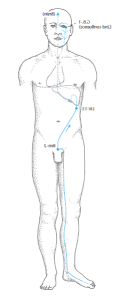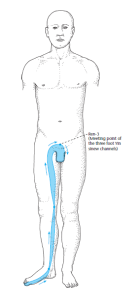This Blog will be divided in 5 parts, and I will present the research that I have done about the Liver organ and to show how important it is to take care of it.
Herbal Formulas and TCM Dietetics Approaches to Balance the Liver – Part 3 – By Doctor Alex Sa Alves
Pathways of the Liver Channel
In accordance with the book Atlas of Acupuncture by Claudia Folks I am describing the 3 different Liver pathways in the body:
a) The Liver Divergent Channel (Zu Jue Yin Luo Mai)
In Traditional Chinese Medicine the pathway for the Liver Divergent Channel is: It originates on the dorsum of the big toe, traverses up the leg to the inguinal area, down to the scrotum, ascends into the hypogastrium, accompanies the stomach, joins with a branch from the liver, penetrates the diaphragm, continues behind the trachea and pharynx, unites with the ocular conduit, and ends in the parietal area of the head. (Image extract from Atlas of Acupuncture by Claudia Folks).
 Clinical importance:
Clinical importance:
- Strengthens the relationship between the Liver and the Gall Bladder (zangfu-Organ systems). Points on the Liver primary channel can therefore be used to treat disorders of the Gall Bladder and vice versa.
- Based on the pathways of the Gall Bladder and Liver divergent channels, points on both channels can be used for disorders of the hips and the lower extremities as well as for disorders of the eye system.
B) The Liver Sinew Channel (Zu Jue Yin Jing Jin)
The Liver sinew channel begins on the dorsum of the big toe follows the dorsolateral aspect of the big toe to the anterior aspect of the medial malleolus, where it binds (jie) ascends the medial aspect of the tibia and binds (jie) at the medial aspect of the knee further ascends the medial aspect of the thigh between the Kidney and Spleen sinew channels reaches the inguinal region, meeting the other foot Yin sinew channels at Ren-3 (zhongji) and continues to the genitalia. (Image extract from Atlas of Acupuncture by Claudia Folks).
 Clinical importance
Clinical importance
Pathology: Stiffness, tension, and distending sensations along the big toe. Pain around the medial malleolus and medial aspect
of the knee. Pain and muscular tension along the medial aspect of the thigh. Disorders of the genital region.
Indication: Pain, tension, muscle contractions and distending sensations along the pathway of the channel. Disorders of the genital region.
C) The Liver Luo-Connecting Vessel System (zu jue yin luo mai).
The Liver luo-connecting vessel system separates from the Liver primary channel at its luo point LIV-5 (ligou). It forms a three-dimensional reticular network, dividing into multiple branches and sub-branches (sun luo, fu luo, xue luo) within the surrounding tissue. Horizontal divisions run to the Interiorly–Exteriorly paired Gall Bladder primary channel; according to some schools of thought, they travel as a transverse Liver luo-connecting vessel to the yuan-source point ➞ G.B.-40 (qiuxu). A longitudinal division ascends the medial aspect of the leg to the genital region, where it branches out. (extract from Atlas of Acupuncture by Claudia Folks)
Clinical importance
Pathology:
1) Counterflow Qi: Swellings and pain of the testicles and scrotum, hernia.
2) Excess (shi): Priapism
3) Deficiency (xu): Itching of the external genitalia
Liver – Pathologies and Laboratory Tests
(with Recommended Herbs and Formulas)
1) Liver Pathologies
Based on the Study “The Liver in Chinese Medicine” By doctor Leon Hammer I will describe main pathologies which I believe are important in a Clinical setting such as: Liver Qi Stagnation and Liver Yang Rising, both sometimes not understood in a whole by the Practioners. Other Pathologies will be describing such as Liver Blood deficiency, Liver toxicity, Liver Qi-Yang deficiency and Liver Separation of Yin and Yang.
a) Liver Qi Stagnation.
In accordance with Dr. Hammer’s Study, he describes that Liver Qi stagnation is associated in the ‘‘system of correspondences’’ with repressed anger. Contrary to this ‘‘system,’’ repressed emotions will instead affect the liver. In fact, anger is generally the result of many frustrations, that has been accumulated inside the person’s mind. The attempt to contain the angry responses to this frustration exercises one of the Liver’s principal functions, to contain emotions and live-in relative safety and harmony in society. Almost every law and rule that regulates society requires the Liver to contain negative and dangerous responses to frustration. Dr. Hammer states in his Study: “It is therefore incumbent upon us to regard the Liver’s ability to stagnate Qi and contain emotion and response as a normal necessary function rather than automatically associated with pathology. In fact, in our time, the problem is not too much containment (stagnation), but too little. Partially, this is the result of the ubiquitous use of the Cold substances, especially marijuana, that has weakened the ability of the Liver to contain emotions and actions”. Also, Dr. Hammer says: “Even more important regarding the Liver’s ability to contain and stagnate is the loss of the ability to tolerate the frustration. The use of the Cold substances has reached into every level of the educational system and into small towns as well as into the cities (with children as young as 9 years old reportedly using drugs)”.
In Traditional Chinese Medicine I have been learned that excess Heat almost always accompanies Liver Qi stagnation. This is at first metabolic heat that the body brings to the Liver to overcome the stagnation. The fate of this Excess Heat is noted under pathologies such as Liver Yin Deficiency and Liver Yang Rising. The principal characteristic of Liver Qi is that it needs to move, not only itself but Qi, in many functions, especially the digestive tract. When Liver Qi moves from the contained to the repressed, and the pressure to move overcomes the forces of resistance (Physics Law that irrepressible force meets the immovably object), the Qi can break loose and will move to the most vulnerable organ, that makes the Liver’s action of ‘‘attacking’’, which means the escaping Liver Qi, or it is moving to the area of least resistance (most vulnerable area or organ). Liver carries with it the Excess Heat that has accumulated from failed attempts by the body, to have metabolic heat to move the Qi. As an example, Dr. Hammer describes that the Liver can ‘‘attack’’ the Lungs in at least 2 ways. The first is the acute attack most often associated with a sudden severe emotional stress, such as a piece of unexpected bad news with which the person is unable to cope. Acutely, the person is unable to take a deep breath and stress becomes panic. Also, that person is feeling that he/she is going to die causes exacerbation and the inability to take a deep breath. Dr. Hammer explains: “The mechanism of action is related to the Liver’s control of the autonomic nervous system in which the bronchial tubes and bronchioles are temporarily in spasm and in which Liver Qi can activate. Another example states by Dr. Hammer: “Palpitations at rest are associated with Liver Qi dysfunction, especially Liver Qi stagnation that leads to Excess Heat brought by the body to overcome the stagnation. When Liver Qi leaves the Liver to attack the most vulnerable organ or area, it brings Excess Heat with it. Both the erratic Qi and the Excess Heat stimulates the vulnerable Heart, unable to maintain homeostasis with palpitations and sometimes tachycardia or atrial fibrillation. Palpitations on exertion are only Heart-related and are the result of effort beyond the Heart’s ability to meet the circulatory demands of the action”. One important issue is the role of Liver Qi in the digestive process. In Traditional Chinese Medicine, it is said that Stomach Qi moves downward. The driving force for this downward movement is Liver Qi. If Liver Qi is deficient, either because the Qi is stagnated or only deficient, that will make the food and the Stomach Qi to become stagnant in both organs: The Stomach and Intestines. The digestive conditions associated with the Liver’s dysfunction are several such as if Liver Qi cannot move food downward, the hydrochloric acid in the Stomach accumulates leading to an environment favorable to organisms such as Helicobacter pylori and the associated gastric and duodenal ulcer. If Qi and food does not move downward and Liver Qi is erratic, they may move upward (regurgitate) into the esophagus along with Stomach acid causing Barrett’s syndrome, a pre-cancerous condition of the esophagus. Regurgitation can also occur with Spleen Qi deficiency. The differentiating factor is that with the Liver attacking, there is often nausea, while with regurgitation due to Spleen Qi deficiency, there is rarely nausea. Liver Qi attacking the Intestine is characterized by only occasional explosive diarrhea, usually associated with acute stress. For the Liver to attack the intestines, they must be vulnerable.
There are other pathologies formed by Liver Qi Stagnation, but in this paper, I am mentioning some of that I saw in Clinical settings. If either of the conditions mentioned above develop, the Liver cannot perform its normal function of moving the Blood both inside and outside of the Liver.
b) Liver Yin Deficiency and Liver Yang Rising
Liver Yang Rising is deficient condition, a result of the Separation of Liver Yin and Yang due to Yin deficiency. Dr. Hammer in his Study explains: “The 2 principal etiologies of Liver Yin deficiency, the Separation of Yin and Yang and rising Liver Yang, are described as follows: Metabolic Heat is required to relieve chronic Liver Qi stagnation. If it fails to overcome the stagnation, Excess Heat accumulates. The Liver mobilizes its Yin to balance the Excess Heat and over time, possibly years, the Yin is depleted. Eventually, the depleted Yin cannot hold onto Yang, Yin and Yang separate, and Yang, without the centrifugal force of the Yin, becomes out of control and dysfunctional. Yang is a lighter energy and rises, becoming the condition, Liver Yang Rising, whose consequences are well known. This is a severe Yin deficient condition. It is not an excess condition simply because the symptoms—intermittent high-pitched tinnitus, throbbing headache, etc—may have excess characteristics. When fluids (Yin) decrease, there is only an apparent, not real, excess. The remedy is to nourish Yin; do not drain Heat”.
Associated conditions could be hot flashes and sweats. Those conditions are often considered Yin-deficient conditions, the commonly used formula for this condition is Two Immortal Decoction (Er Xian Tang), a formula that has 3 Yang nourishing herbs and 1 blood nourishing herb (as described below). Hot flashes occur when either Yin or Yang is sufficiently deficient to cause a Separation of Yin and Yang. More often, the deficiency is in Yang and while the heavier Yin tends to remain in the body, the lighter Yang rises and leaves the body as a hot flash. When the separation becomes severe, the Yin follows the Yang, and we have hot (Yang) sweats (Yin). The principal symptom of this general Yin deficiency is extreme dryness of the entire body, irritability, and agitation (agitated depression). Water satisfies thirst for only a short time. Tinnitus with a cricket sound is common. (The Traditional Chinese Medicine texts list extreme symptoms such as ‘‘Five Hearts Hot’’ – chest, palms, and soles, that a practitioner might encounter once in his/her career, and malar flush with extreme Yin deficiency). Night sweats as described above are due to a Separation of Yin and Yang often due to Yang deficiency.